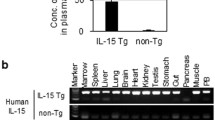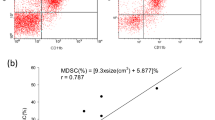Abstract
To generate an appropriate model for human acute myeloblastic leukemia (AML), we have successfully established a human hematopoietic growth factor-dependent AML cell line (TF-1 and UT-7/GM)-ascites model using human granulocyte-macrophage colony-stimulating factor (hGM-CSF)- and human interleukin 3 (hIL-3)-releasing transgenic (Tg)-SCID mice. When 1×107 cells of TF-1, a human erythroleukemia cell line, were transplanted into the peritoneum of irradiated Tg-SCID mice (TF-1 ip/Tg-SCID mice), TF-1 cells grew in both the single cell suspension form (asTF-1) and solid form in ascites and invaded various tissues: lungs, liver, pancreas, and genitals, 3–6 weeks following transplantation. Subsequently, 0.5–1×107 cells of UT-7/GM, a subline of the UT-7 human megakaryoblastic leukemia cell line, grown in the back of hGM-CSF Tg-SCID mice after subcutaneous inoculation, were transplanted into the peritoneum of other irradiated hGM-CSF Tg-SCID mice. After 4 weeks, UT-7/GM cells (asUT-7/GM) also grew in the same manner as TF-1 cells in hGM-CSF Tg-SCID mice. Analysis of the cells from the peritoneum and tissues by PCR amplifying ALU and human GM-CSF receptor β sequences and by immunohistochemical staining using anti-human CD45 revealed that they possessed the original characteristics of the parental cells. To confirm the usefulness of this human AML-ascites model, experimental treatment of AML cells grown in these mice was carried out with a differentiation inducer, delta-aminolevulinic acid (δ-ALA), which induces hemoglobin synthesis for TF-1 in vitro and is thus regarded as an anti-leukemia drug candidate. Unexpectedly, growth promotion of TF-1 cells was observed in the treated TF-1 ip/hIL-3 Tg-SCID mice without differentiation to erythroid cells after treatment with δ-ALA (5 mM) for 7 days. These results indicate that Tg-SCID mice can support the growth of human hematopoietic growth factor-dependent AML cell lines which are usually rejected by SCID mice, without modification of the parental cell characteristics. In addition, this Tg-SCID leukemia-ascites model may become a useful preclinical tool for estimation of drug efficacy in vivo, since the drug candidate which was promising in vitro did not act in the same manner in vivo.
Similar content being viewed by others
Author information
Authors and Affiliations
Additional information
Received: October 7, 1998 / Accepted: January 22, 1999
Rights and permissions
About this article
Cite this article
Fukuchi, Y., Miyakawa, Y., Kizaki, M. et al. Human acute myeloblastic leukemia-ascites model using the human GM-CSF- and IL-3-releasing transgenic SCID mice. Ann Hematol 78, 223–231 (1999). https://doi.org/10.1007/s002770050506
Issue Date:
DOI: https://doi.org/10.1007/s002770050506




